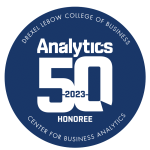At its core, predictive analytics is a method for estimating the likelihood that a trend will persist.
While modern tools have advanced this process significantly, the practice of using predictive techniques to analyze market direction and demand is far from new. Before the advent of computers, setting marketing goals often relied on educated guesses. More sophisticated methods, such as the Expert Consensus approach, involved repeatedly gathering insights from experts on market trends or future demand to form a consensus. Over time, these techniques have evolved, and the accuracy of predictive data has dramatically improved, enabling more informed and reliable decision-making.
Predictions can take many forms, such as estimating the price of a house, conducting risk analysis, and content creation by predicting the next word in a sentence or forecasting market trends like direction, expansion, consolidation, or demand.
So What Are Predictive Analytics?
Predictive analytics is a branch of data science that uses statistical techniques and machine learning (ML) to analyze current and historical data to predict future outcomes or trends. It’s a way of looking forward, informed by the patterns and insights of the past.
For example, when you begin typing a keyword into Google’s search bar, the suggestions that appear are generated by algorithms trained on vast amounts of previous search data. This same principle drives predictive analytics used in marketing strategies — helping businesses plan campaigns, optimize spending, and anticipate market changes.
Predictive Analytics Under the Hood
Building accurate predictions starts with solid data. The algorithms at the heart of predictive analytics require robust datasets with enough examples to identify reliable patterns. Think of it as an ongoing learning process that improves as the system processes more data.
For example:
- The algorithm might learn that when conditions A, B, and C occur together, result D happens 80% of the time.
- However, when only conditions A and B occur, the likelihood of result D drops to 45%.
By identifying such patterns, algorithms can calculate a confidence score, providing a measure of reliability for their predictions. Further accuracy of a prediction often depends on both the quality of the data and the sophistication of the algorithm.
Goals for Marketing Predictions
With so much of our business data now available in digital form, we can blend multiple data sources to create highly sophisticated predictions. For example, estimating sales per region requires at least a basic understanding of regional demand and current market supply. However, by incorporating additional factors—such as whether demand exceeds, matches, or saturates a region—you could dynamically adjust pricing models or tailor product offerings for better product-market fit.
Consider these scenarios where blending data enhances predictive accuracy:
- Sales Seasonality and Weather: Measuring the impact of weather on sales can significantly refine advertising strategies and budget allocations.
- Competitor Proximity: Understanding how the presence of nearby competitors affects the cost of sales in a region can guide resource allocation and marketing efforts.
- Brand Sentiment and Sales Trends: Analyzing the correlation between brand sentiment (e. gleaned from social media, reviews, etc.) and sales trends helps refine campaigns and anticipate demand shifts.
Types of Data Analytics
In the world of data-driven decision-making, there are four main types of analytics, each serving a distinct purpose in understanding and leveraging information:
Descriptive Analytics: What Happened?
This type of analytics looks at historical data to provide insights into past performance. It’s like looking in the rearview mirror, giving us a clear picture of what has already occurred.
Diagnostic Analytics: Why Did It Happen?
Diagnostic analytics delves deeper, examining data to understand the causes behind past events or outcomes. It’s akin to being a detective, uncovering the reasons behind specific trends or anomalies.
Predictive Analytics: What Will (or Is Likely to) Happen?
This is where we start looking forward. Predictive analytics uses historical data and statistical modeling to forecast future outcomes or behaviors. It’s like having a crystal ball, albeit one based on data and probabilities rather than magic.
Prescriptive Analytics: What Should We Do?
The most advanced form of analytics, prescriptive analytics, not only predicts what might happen but also suggests actions to take advantage of future opportunities or mitigate risks. It’s like having a wise advisor, providing recommendations based on comprehensive data analysis.
Predictive Modeling Techniques
There’s no “one-size-fits-all” approach in predictive analytics. Different techniques work better depending on the problem at hand. Here’s a quick overview:
Regression Analysis
Used when you want to understand relationships between variables (e.g., how advertising spend impacts sales).
- Strengths: Simple and interpretable.
- Weaknesses: Limited when data relationships are non-linear.
Decision Trees
These models work like a flowchart, mapping decisions and their potential outcomes.
- Strengths: Easy to visualize and interpret.
- Weaknesses: Can become overly complex with large datasets.
Neural Networks
Inspired by the human brain, these models excel at identifying patterns in large and complex datasets.
- Strengths: Extremely powerful for tasks like image recognition or advanced predictions.
- Weaknesses: Requires significant computational resources and expertise.
Why Use Predictive Analytics?
Predictive analytics isn’t just another buzzword in the marketing world — it’s a game-changer that’s reshaping how businesses operate and compete. Here’s why incorporating predictive analytics into your marketing strategy isn’t just smart — it’s essential.
Enhance ROI
Predictive analytics supercharges your ROI by allocating resources more efficiently:
- Campaign Optimization: Forecast which campaigns will perform best, investing more in high-potential strategies.
- Audience Targeting: Identify the most responsive segments, focusing efforts on high-value targets.
- Budget Allocation: Distribute your marketing budget with precision across channels and tactics.
Improve Decision-Making
Replace guesswork with data-driven insights:
- Scenario Planning: Run “what-if” scenarios to anticipate outcomes of different strategies.
- Trend Identification: Spot emerging trends before they become mainstream.
- Risk Mitigation: Flag potential issues proactively, saving time and resources.
Improve Customer Retention
Boost retention rates with predictive insights:
- Churn Prediction: Identify at-risk customers and intervene with targeted campaigns.
- Personalization at Scale: Anticipate individual needs for stronger customer relationships.
- Lifecycle Marketing: Deliver the right message at the right time through the right channel.
Drive Operational Efficiencies
Streamline internal operations:
- Resource Allocation: Forecast busy periods to better allocate human resources.
- Content Creation: Guide efforts by identifying resonant topics and formats.
- Inventory Management: Align promotional efforts with stock levels and supply chain capabilities.
- Automated Decision-Making: Free up marketers to focus on strategic, creative tasks.
In Action: Predictive Analytics in Marketing
Predictive analytics isn’t just theoretical—it’s a powerful tool with numerous practical applications in marketing. While the possibilities are virtually endless, let’s explore some common use cases that demonstrate the transformative power of predictive analytics:
Demand Forecasting
Demand forecasting is about predicting future demand for your products or services. By analyzing historical data, market trends, and external factors like seasonality or economic shifts, businesses can anticipate customer needs with remarkable accuracy.
- How it works: Predictive models crunch data from various sources—sales history, website traffic, social media engagement, even weather patterns—to forecast future demand. This allows businesses to optimize inventory, adjust production, and align marketing efforts with anticipated customer needs.
- Benefits: Improved inventory management, reduced waste, and more targeted marketing campaigns.
Customer Retention & Churn
Keeping existing customers is often more cost-effective than acquiring new ones. Predictive analytics helps identify which customers are at risk of leaving and why, allowing businesses to take proactive measures.
- How it works: By analyzing patterns in customer behavior—such as purchase frequency, engagement with marketing materials, or customer service interactions—predictive models can flag customers who show signs of potential churn.
- Benefits: Reduced customer churn, increased lifetime value, and more efficient allocation of retention resources.
Customer Segmentation
Not all customers are created equal. Customer segmentation uses predictive analytics to divide your audience into distinct groups based on shared characteristics, behaviors, or preferences.
- How it works: Predictive models analyze vast amounts of customer data—demographics, purchase history, browsing behavior, etc.—to identify meaningful patterns and group customers accordingly.*
- Benefits: More personalized marketing strategies, improved product development, and more efficient resource allocation.
*Note: it’s important to recognize the legal and ethical standards for Customer Segmentation. Privacy laws like GDPR and others should always be followed; it’s equally important to recognize potential privacy concerns with other customer data as well.
Expectation & Goal Setting
Predictive analytics isn’t just about understanding customers—it’s also about setting realistic, data-driven goals for your marketing efforts.
- How it works: By analyzing historical performance data and market trends, predictive models can forecast expected outcomes for various marketing initiatives. This allows businesses to set achievable goals and allocate resources more effectively.
- Benefits: More accurate forecasting, better resource allocation, and improved performance tracking.
Personalized Campaigns
As we’re bombarded with information today, customized content helps us find what really matters. Predictive analytics enables hyper-personalized marketing campaigns that speak directly to individual customer needs and preferences.
- How it works: By analyzing customer data across multiple touchpoints, predictive models can anticipate individual customer preferences and behaviors. This allows marketers to tailor content, offers, and even delivery channels to each customer.
- Benefits: Increased engagement rates, higher conversion rates, and improved customer satisfaction.
How to Implement Predictive Analytics in Your Marketing
Implementing predictive analytics in your marketing strategy isn’t just about adopting new technology—it’s about embracing a data-driven mindset and fostering cooperation across your organization. To successfully incorporate predictive analytics into your marketing workflows, you need to establish the right infrastructure, cultivate a culture of data-driven decision-making, and ensure cross-departmental collaboration.
Data Sources
The foundation of effective predictive analytics lies in high-quality, relevant data. Identifying and leveraging the right data sources is crucial for generating accurate predictions and actionable insights.
Marketers should tap into a variety of data sources, including:
- Customer Relationship Management (CRM) systems
- Website analytics (e.g., Google Analytics)
- Social media platforms
- Email marketing metrics
- Point-of-sale (POS) data
- Customer surveys and feedback
- Third-party market research
- Competitor analysis tools
- Ad platform data (e.g., Google Ads, Facebook Ads)
- Mobile app usage data
By combining these diverse data sources, marketers can create a comprehensive view of their customers and market landscape, leading to more accurate predictions and targeted strategies.
Tools & Software
Selecting the right tools and software is crucial for effectively implementing predictive analytics in your marketing efforts.
Here are some popular options that can help marketers incorporate predictive analytics into their workflows.
Software & Data Platforms
- IBM SPSS: A comprehensive statistical software suite with predictive modeling capabilities
- SAS Advanced Analytics: Offers a range of predictive modeling and machine learning tools
- RapidMiner: An easy-to-use data science platform with predictive analytics features
Marketing-Specific Platforms
- Google Analytics 360: Provides advanced analytics and predictive insights for website data
- Adobe Analytics: Offers predictive capabilities within its marketing analytics suite
- Salesforce Einstein: AI-powered predictive analytics integrated with Salesforce CRM
Language-Specific Platforms
- Python with libraries like Scikit-learn and TensorFlow: For custom predictive modeling
- R with packages like caret and forecast: Open-source software for statistical computing and predictive modeling
Visualization Tools
- Tableau: Data visualization tool with some predictive analytics features
- Microsoft Power BI: Business intelligence tool with some predictive analytics capabilities
When choosing tools and software, consider factors such as ease of use, integration capabilities with your existing systems, scalability, and the specific predictive modeling techniques required for your marketing goals.
It’s worth noting that AI-powered solutions are becoming increasingly available in this space. While still in the early stages of adoption, these tools are evolving rapidly and may offer additional capabilities for predictive analytics in the future. However, the focus should remain on selecting tools that best fit your current needs and can integrate well with your existing marketing stack.
Following the Roadmap
Implementing predictive analytics in marketing requires a structured approach. There are clear stages to any predictive analytics exercise that should be followed for success.
Here’s a roadmap that combines the outlined steps with our CEO’s insights
1. Define the project.
What do you want answers to. Understand what analytics would be useful to run your business and what analytics you need to help your decision-making. Identify the specific marketing goals and outcomes you want to predict.
2. Collect the data.
Consider all of the sources available to you. Take inventory of the data you do have, and all of the data you’d like to have for additional insights. This means identifying all of your data sources, be it your website data, point-of-sale data, customer profile data, CRM data, etc.
3. Process the data
Now that you’ve gathered your data – you need to process it. This may be a strenuous process, but it’s important that your data is ready to process and analyze. This may mean cleaning and structuring your data, or scrubbing your data of any personal or sensitive information.
4. Model the data
Using the techniques and tools above, now it’s time to model your data. You’ll want to use the right technique for your data and the types of outcomes you’re looking for. Find a model and technique that works for your needs, and begin making sense of the data – and its conclusions.
5. Interpretation
What is the data telling you? At this stage, you’ll want to analyze the different visualizations and data to determine various relationships and outputs. But most importantly – we’ll want to begin interpreting the answers to the initial questions you started with.
6. Action
Now what? It’s imperative we turn our findings into actionable steps and begin integrating our marketing strategies.
By following this roadmap, marketers can systematically approach predictive analytics, from identifying relevant data sources to implementing predictive models that drive actionable insights for their marketing strategies.
Challenges & Considerations
Although the promise of predictive analytics is immense, implementing it isn’t without its challenges. Data quality and integration issues are among the most common roadblocks. Organizations need to clean, organize, and harmonize their datasets before they can extract meaningful insights.
Additionally, predictive models are only as good as the data they’re built on. Without comprehensive, accurate, and timely data, predictions can mislead rather than inform. Partnering with experts like FourFront can help overcome these hurdles.
The Future of Predictive Analytics
The future of predictive analytics in marketing is poised for significant growth and innovation. As data sources continue to expand and diversify, marketers will have access to increasingly granular insights, enabling hyper-personalized customer experiences. Advanced machine learning algorithms and AI will play a larger role, automating complex analysis and uncovering patterns that humans might miss.
We can expect to see predictive analytics becoming more accessible to businesses of all sizes, with user-friendly tools and platforms democratizing its use. Real-time predictive capabilities will become more prevalent, allowing marketers to make instant decisions based on up-to-the-minute data. As privacy concerns evolve, predictive analytics will also adapt, focusing on ethical data use and transparency in how predictions are made.
Getting Started
Integrating predictive analytics into your marketing strategy is no longer a luxury—it’s a necessity for staying competitive in today’s data-driven landscape. While the potential benefits are immense, the process of implementation can be complex and challenging. It’s crucial to get it right from the start to avoid costly mistakes and ensure you’re extracting maximum value from your data.
This is where FourFront’s predictive analytics services come in.
As experts in the field, we bring a wealth of experience and cutting-edge tools to help you navigate the complexities of predictive analytics. Our team works closely with you to understand your unique business needs, identify the most relevant data sources, and develop customized predictive models that drive real results. From demand forecasting to customer segmentation and personalized campaigns, we’re here to help you unlock the full potential of predictive analytics in your marketing efforts.
A quick authorship note:
This final piece was a collaborative effort between Anthony Lavadera, Bob Scavilla, and Jared Groff.









